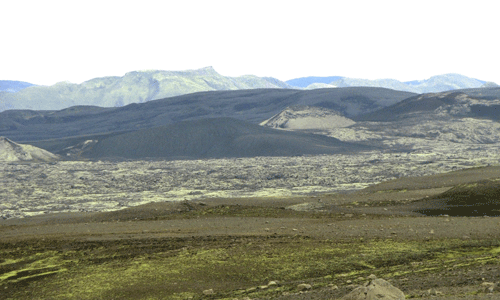Note: the description of events given below is taken from contemporary written accounts, summarized and translated from the Icelandic by Thordarson and Self (Bulletin of Volcanology, v. 55, p. 233-263, 1993).

Weak seismic tremors were first reported in the areas around Laki Mountain and the Skafta River in mid-May, 1783. The seismic activity grew in intensity over the next several weeks, until people were so unsettled by it that they took to sleeping in tents outside of their homes. The first fissure opened at 9 AM on June 8, 1783, producing fire fountains that were visible from the nearby towns of Skaftártunga, Medalland, and Sída. By reconstructing the line of sight from Prestbakki over Mörtunga, a ranch mentioned by name in Steingrímsson’s account, it can be determined that these first fire fountains were located near Hnúta, at the southwest end of the Laki fissures. Strong earthquakes were felt again on June 9-11, and were followed by more fire fountaining a bit farther to the north (contemporary accounts say the second fires were to the north – most likely they were actually to the northeast, following the trend of the fissure). The eruptions of June 8 and June 10 produced tephra deposits up to 60 cm thick extending to the north and east, and lava flows extending southwest towards the Skaftá River Gorge. Another earthquake swarm on June 13 preceded the rupture of a third fire fountain on June 14. This event produced a significant amount of Pele’s hair, which we learned about in Module 1. Lava flows from the June 14 fissure followed a somewhat more southerly path before joining with the flows still emerging from the June 8 and June 10 fissures at the Skaftá River Gorge. An earthquake on June 23 was followed two days later by explosive fountaining that peaked on June 27-28, raining ash and tephra on nearby towns. Interaction with the shallow water table resulted in a phreatomagmatic eruption, producing a large tuff cone centered on the fourth fissure. Lava flows emerging from the mouth of the Skaftá River Gorge were more or less continuous from June 12-29, with a surge following the opening of each new fissure. The fifth and most sustained explosive event on the Laki fissures occurred between June 30 and July 25, 1783. The initiation of this stage is not well documented, but it is known that earthquakes occurred on June 30, and tephra fell on local villages July 9-10. It is believed that all of the first five fissures were fountaining during this time. A lava surge—the last to be reported—emerged from the Skaftá River Gorge July 13-14. Tephra fall and seismic activity continued intermittently through July 25. The fissure that opened during this episode bisected the western flank of the older Laki hyaloclastite mountain, from which Lakagígar takes its name.
